
JMeter Regex Extractor: How to Extract Variables
You're surely here because you are looking for the Ultimate Tutorial explaining how JMeter's Regex Extractor works.
Great News! This post covers everything you need to know about variable extraction using Regular Expressions.
We'll learn many concepts along the way:
- How to re-use JMeter variables (like
${foo}) in subsequent samplers and controllers (If Controller, Response Assertion, etc.), - How to extract single and multiple values from an HTTP message body,
- How to write lightning fast regular expressions, and boost JMeter speed,
- and more!
By the way, we suggest you to take a look at our tutorials explaining how to use Json Extractor and XPath Extractor too.
Let's have some fun!
JMeter Regex Extractor¶
How It Works¶
JMeter Regular Expression Extractor is designed to extract content from server responses using Regular Expressions. It is part of JMeter's Post Processors family.
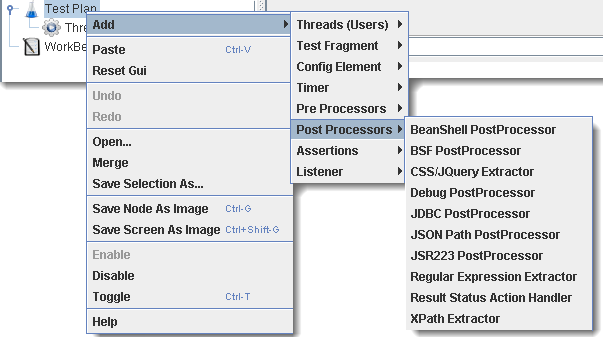
As you can see, there are many other useful post-processors as well like:
- Json Extractor: extract content using JsonPath expressions,
- XPath Extractor: extract content using XPath Expressions,
- JSR223: run groovy / javascript / java scripts on the sample result.
How do we use it? Simply place it under a sampler like on the screenshot below.
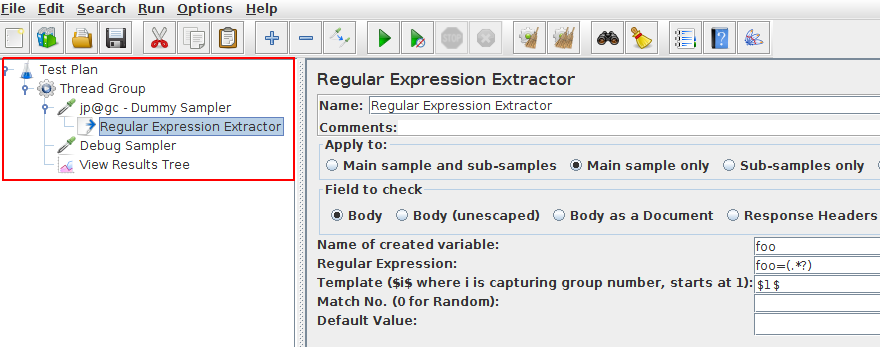
Here we have the regexp extractor placed under a Dummy Sampler. The regular expression will be executed after the dummy sampler.
Post-Processors are sequentially executed in the order they are defined under a sampler.
JMeter's Regex Extractor is a Post-Processor:
- Must be placed as sampler child: the post-processor is placed under a sample,
- Runs after the sampler has been run: and executes some logic on the sample result.

Now that we see how the extractor works, what's really the purpose of using it?
Correlating Dynamic Values¶
Well, that's pretty simple: handling dynamic parameters. Typically, CSRF tokens fall into this category. But, they're not the only ones: Well, that's pretty simple: handling dynamic parameters. Typically, CSRF tokens fall into this category. But, they're not the only ones:
- Handling
.NETviewstate, - Managing Oauth2 access and refresh tokens,
- and more.
To sum up:
Dynamic parameters are session or request based tokens whose value changes frequently and is sent within a server response.
Well the major drawback of protocol level testing is that all the browser side code or logic is not replayed. And this sometimes includes critical values not being computed/replaced automatically.
That's why dynamic parameters must be extracted and reinjected in subsequent requests. That's what we call correlations.
First before jumping into an example, here is a link to the documentation about the Regular Expression Extractor on JMeter's Website.
Simulating Dynamic Behavior¶
Before we dive into the greater details, let's see a practical example of dynamic parameter correlation.

For this example, we'll use our Petstore Demo. The link highlighted in red translates into the following HTML:
<div id="MainImage">
<div id="MainImageContent">
<map name="estoremap">
...
<area alt="Dogs" coords="60,250,130,320"
href="Catalog.action?viewCategory=&categoryId=DOGS" shape="RECT" />
<area alt="Reptiles" coords="140,270,210,340"
href="Catalog.action?viewCategory=&categoryId=REPTILES" shape="RECT" />
<area alt="Cats" coords="225,240,295,310"
href="Catalog.action?viewCategory=&categoryId=CATS" shape="RECT" />
...
</map>
<img height="355" src="../images/splash.gif" align="middle"
usemap="#estoremap" width="350" /></div>
</div>
What if we want to view a random category? That's pretty easy with the regular expression extractor.

First, we define a sampler to request the catalog homepage.

Then, we extract the categoryId from the server response using the following config:
- Regex:
categoryId=(.*?)", - Template:
$1$, - Match Nr:
0(which means random).

Finally, we reinject the ${categoryId} variable into the request path, which becomes:
/actions/Catalog.action?viewCategory=&categoryId=${categoryId}
Let's run the sample!


As you can see, the random category selection is fully working! We got two different categories on each run.
That's a great example of how you can leverage Extracting Post Processors to simulate a user behaving dynamically.
Extraction Methods¶
Extracting One Value¶
So first we will work on the following HTML response:
<!DOCTYPE html>
<html>
<body>
<form>
First name:<br>
<input type="text" name="firstname" value="John"><br>
Last name:<br>
<input type="text" name="lastname" value="Cena">
</form>
</body>
</html>
It is quite simple, but will do nicely. And once again I think it is better to start with an easy example.
Regarding our test protocol, this static page will be hosted in a local apache, so we will use the following configuration:

We will then try to extract the value of some of or all the inputs using regexp post processors. And speaking of regex, we're going to use the following one:

- Field to check: We will stick to the response body here, since we want to extract from the HTML.
- Reference Name: What's really important here is the
Reference Namesince this will be the variable name we can use later on. - Regular expression: The regular expression field contains the regex itself, in our case we want to extract what's between
value="and"and using.+?we will extract any character (except newline chars:\n \r) that occurs one or more times. Since we want to use this value later on we've put parenthesis around it. This will place it in what's called a group. - Template: And speaking of group, that's exactly what you can see in the template field. Here we state that the value of the SingleName variable should contain the first group.
- Match No.: The match number is appropriate when the regex corresponds to several values in the response.
Which is true in our case, if you look at the HTML there are two
value="fields that could correspond. For now we want to keep it simple and will always extract the first one. - Default value: And last the default value is the value of the SingleName variable when no match was found.
Now we will be using the Debug sampler to control the extracted value of our regex:

This sampler will let us know the current value of all variables, so I strongly suggest you use it too. It is a very good way to learn how regex work through quick trial and error.
In our case we can see the following values:
SingleName=`John`
SingleName_g=`1`
SingleName_g0=`value="John"`
SingleName_g1=`John`
The first one is the most commonly used, since it is the variable itself, it contains the first occurrence of our regex in the HTML.
If you want to try it out on your side, you can copy/paste the HTML and regex in a testing tool like Regex101.
The other values are not always proper, but they give us some details:
_g: The number of groups, ie regex within parenthesis._g0: value of group 0 that contains the extracted value along with the boundaries._g1: value of group 1, useful in case you have nothing specified in the template, or if you have several groups, but more on that later.
To conclude this first example, we can see the value we extracted is the one we expected to have, which is the only thing that matters. Also we've seen that there are other variables created automatically by JMeter, so now we will have a closer look at them.
Extracting Multiple Values¶
A use case that is often encountered is when you want to extract not only one value, but the list of all values. This is what is called multiple occurrences. The regex is not much different:
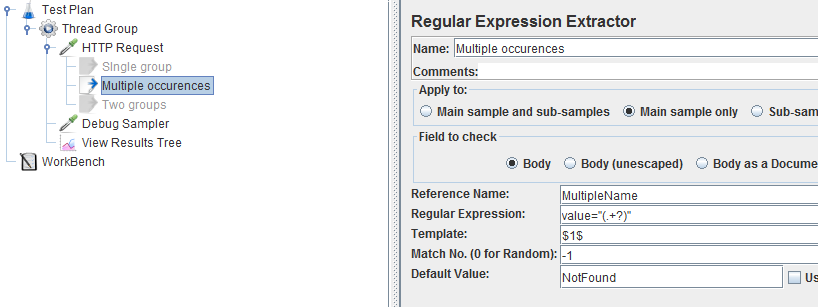
I've just used a different name and a negative occurrence number. This will tell JMeter to extract all available occurrences. Note that occurrence 0 tells JMeter to extract one occurrence randomly amongst all that are available.
And the result is much different this time:
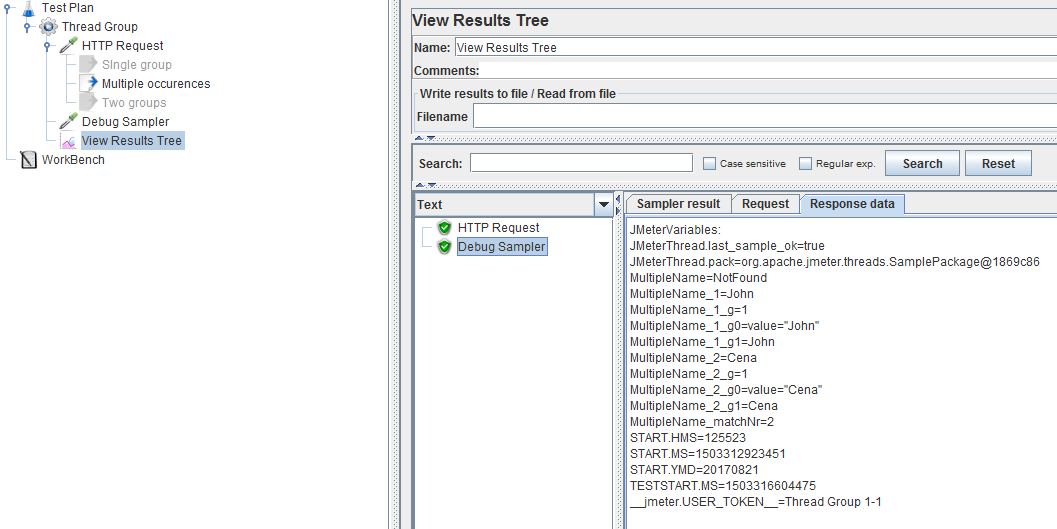
We see the following values:
MultipleName=NotFound
MultipleName_1=John
MultipleName_1_g=1
MultipleName_1_g0=value="John"
MultipleName_1_g1=John
MultipleName_2=Cena
MultipleName_2_g=1
MultipleName_2_g0=value="Cena"
MultipleName_2_g1=Cena
MultipleName_matchNr=2
The first one now contains the default value, this is because it's mandatory to refer to an occurrence number now.
To do that you must add _1 at the end of the variable name, and before the group number.
Which is why we can see the same 4 values than last time but with _1 in their variable name and also 4 other values corresponding to the second occurrence.
The _matchNr tells us how many occurrences were extracted, this can be convenient when you want to loop on them, although I would recommend the For Each loop that makes this process easier.
Extract Linked Values Using Groups¶
So this time we will have a look at multiple groups. The regex configuration will be as follows:
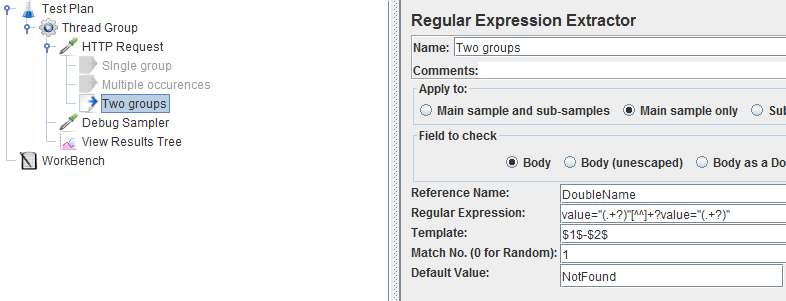
I think it's worth zooming on the regex:
value="(.+?)"[^^]+?value="(.+?)"
**The first part remains the same, so we will still extract the value of the first HTML parameter.
Then we use [^^]+? to specify that there can be any chars between the first section and what comes next.
Using [^^] guarantees we will not even stop at end of lines, technically it means everything except the ^ sign.
And then we have the first section again, this time to extract the value of the second HTML parameter.
The template is also different since we have two groups, I decided to use a value template with group 1, a dash, and group 2.
This way when we use the variable name instead of a specific group, we expect something like this: John-Cena.
And the result is:
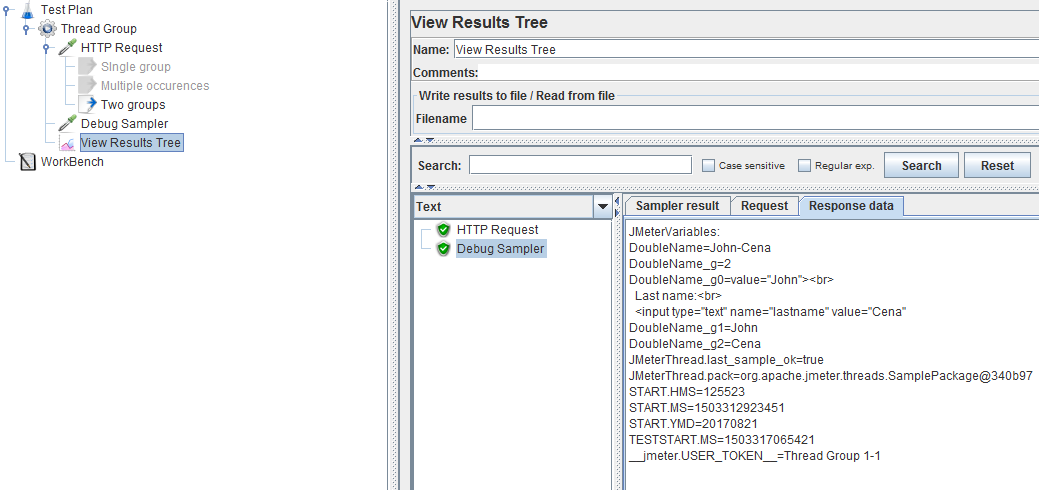
Let's have a closer look at the values:
DoubleName=John-Cena
DoubleName_g=2
DoubleName_g0=value="John"><br>
Last name:<br>
<input type="text" name="lastname" value="Cena"
DoubleName_g1=John
DoubleName_g2=Cena
As you can see the first value is what we expected to have.
Then we are told we have two groups this time since _g=2.
And _g0 which includes the boundaries around the values is quite large since we specifically said we should include new lines.
We can also use the group names to get either one of the two values now (_g1 or _g2).
Although this example might not really make sense in a real life situation (we would use multiple occurrences) I think it goes a long way to show how you can easily extract several values with one regex. This is extremely handy when extracting values that are linked together (first name and lat name, etc...).
Extract Multiple Lines¶
Sometimes, it can happen that you want to extract a ***multiline value**. It's a value dispatched over multiple lines. As stated in JMeter Regex Meta-chars, The following Perl5 extended regular expression are supported by JMeter:
(?m):menables multiline treatment of the input.
Multi-line (?m) modifier is normally placed at the start of the regex. For Example: (?m)value="(.?+)". In this case, the value between double quotes (") is matched on multiple lines.
Example Regular Expressions¶
Before I conclude, I'd like to share some regex example I often use. Feel free to share your best regex in the chat below as well!
When dealing with HTML parameters, you want to extract values that are between double quotes ".
To do so, I always use the following regex, since it will stop only when encountering the next double quote.
And this can be practical on some applications:
[^"]+?
When dealing with more complex situations, you can sometimes easily create a simple regex by extracting just numerical chars:
\d+?
\w+?
Also the multi-line regex we've seen earlier can be useful when dealing with very long values:
[^^]+?
And of course you can create your own character classes depending on the situation, here for a uuid (ex:123e4567-e89b-12d3-a456-426655440000):
[a-zA-Z0-9-]+?
How OctoPerf Helps¶
As we've seen regex are pretty powerful but at the same time they require experience. But since they are the most efficient way to extract data it is important to be able to use them efficiently.
For this reason, we have created a simple mode on top of the regex post processor in OctoPerf. This will allow you to just select the text you want to extract:
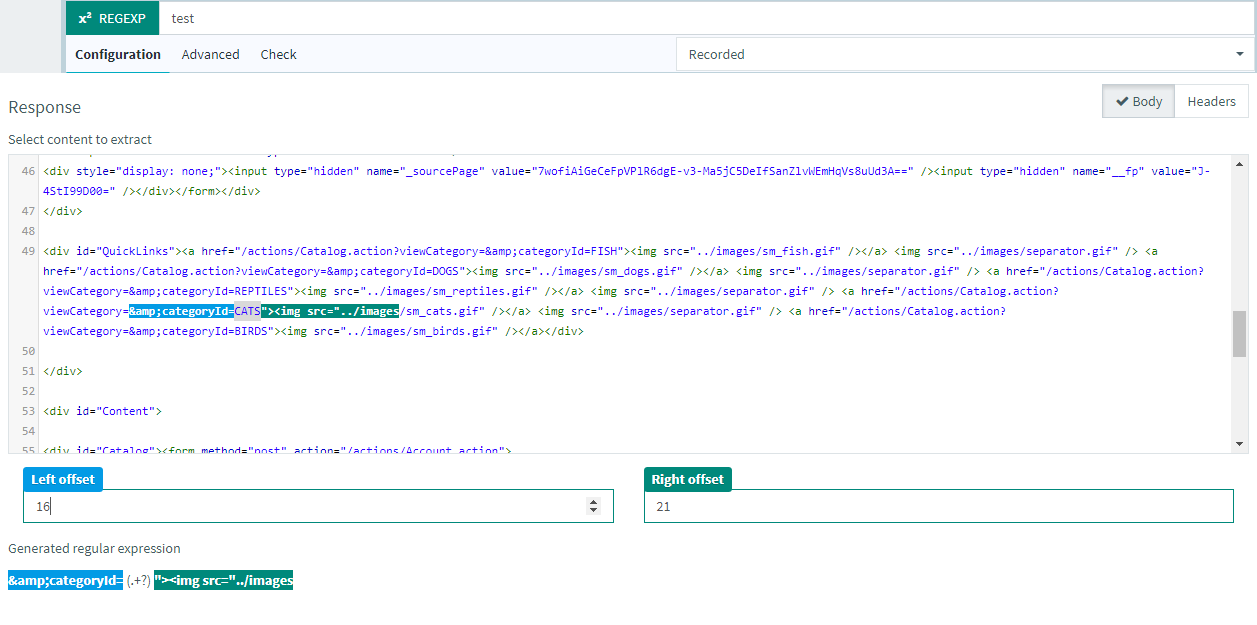
And when you go to the advanced tab, the regex, template, match number and default value have been pre-filled with your selection:
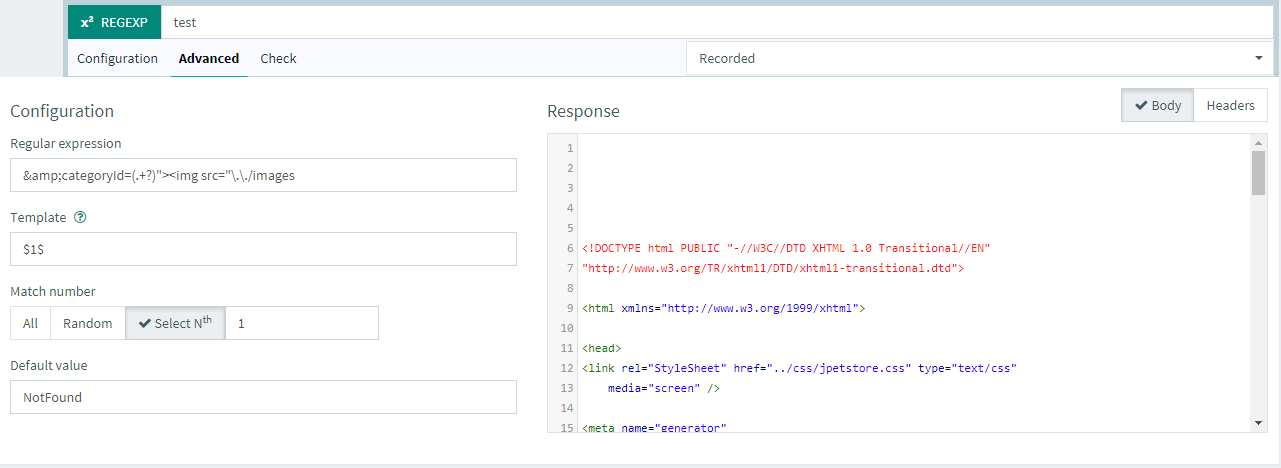
Any special char will also be escaped automatically, and as you can see you have the same possibilities than in JMeter. What makes it even better, is that you can instantly test it through the "check" tab:

Last but not least, since you're likely to have to use the same regex in several places, instead of copy pasting it manually, you can use our correlation rule engine to automate the search and replace of your regex.
Q&A¶
Wouldn't it be better to use the new CSS/jQuery extractor. Are there any advantages to using regular expressions?
Although CSS / JQuery extractors may help to extract content from the server response more easily, there is a trade-off: they consume way more CPU and Memory resources. The learning curve is also stepper. Regexp are usually wide-spread in many loading tools while CSS / JQuery extractions seem to be limited to JMeter.
As they parse the response before processing it to extract the content, you may end up simulating less users per load generator.
What If I don't know how to write regular expressions?
Take a look at Regexp Coach, it's a great tool to test regular expression on arbitrary content.
Mastering Post-Processors¶
JMeter Post-Processors are at the heart of Performance Testing:
And since protocol based testing is still the best way to stress an application it is important to understand at least the basics of this process.
Want to improve your JMeter skills? There are some great JMeter Books out there!
